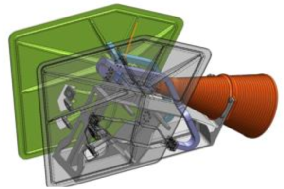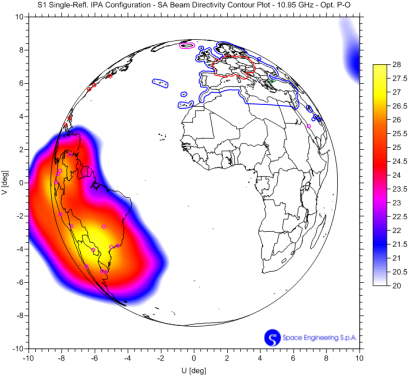Flexible payload components are required by operators in today's highly competitive satellite communications market. In particular, to be able to dynamically modify antenna beam patterns in orbit to respond to market demands is critical. Moreover, payload designs must be suitable for use in diverse orbital slots, thereby simplifying “sparing” and reducing overall satellite acquisition costs.
 In response to these challenges, Space Engineering – a subsidiary of Airbus Defence and Space - has designed an innovative high-power multi-beam broadcast antenna that allows operators to dynamically configure shaped beams for their customers. In parallel, the Italian company has also developed a dual-polarization feed system that can handle fixed satellite services as well as broadcast satellite services transmitting and receiving on the same antenna.
In response to these challenges, Space Engineering – a subsidiary of Airbus Defence and Space - has designed an innovative high-power multi-beam broadcast antenna that allows operators to dynamically configure shaped beams for their customers. In parallel, the Italian company has also developed a dual-polarization feed system that can handle fixed satellite services as well as broadcast satellite services transmitting and receiving on the same antenna.
The components were developed in two projects supported by ESA under ARTES 5.1. Both the antenna and the feed are key baseline technologies that Space Engineering is contributing to the Eutelsat Quantum programme.

Eutelsat Quantum, a Public Private Partnership between ESA, Eutelsat and the European space Industry, will be a new class of satellites that, according to Eutelsat, should offer “exceptional flexibility in terms of coverage, bandwidth, power and frequency configurability for operators active in government, mobility and data markets.”
With a Eutelsat Quantum satellite, the operator will be able to reconfigure via software the uplink and downlink beams in terms of RF power, spectrum frequency, geographical coverage, and DC power without requiring duplicate equipment.
The use of active antennas enables Eutelsat Quantum to provide multiple coverage areas (shaped beams, spot beams or a combination of both) from a single aperture and provides highly flexible power sharing between different service areas. The Ku-band active reconfigurable antenna architecture designed by Space Engineering was able to meet the Quantum mission flexibility requirements in terms of frequency plan, power and coverage.


The first Eutelsat Quantum-class satellite, due to be launched in 2018, will be built by Airbus DS in the UK on the basis of a new satellite platform currently being developed by its British affiliate Surrey Satellite Technology Ltd (SSTL). As part of its payload, it will carry Space Engineering's new feed system and Ku-band antenna, giving them the required in-flight validation.
“These new components are part of a product line that Space Engineering is developing to meet the needs for flexible payloads” said Sabino Titomanlio, Head of Marketing and Sales, Space Engineering. “We anticipate that new satellites for broadcast applications will be designed with flexibility foremost in mind, therefore the potential market should be substantial.”
“In the course of our ARTES projects, ESA has been extremely supportive, from the baseline definition phase up to the test results evaluation,” Titomanlio said. “This support has been of paramount importance for Space Engineering to achieve our project goals, and, even more important, to pave the way for the exploitation of the results in the Quantum programme.”
For more information, contact Sabino Titomanlio (Space Engineering)
Image credits: Space Engineering




